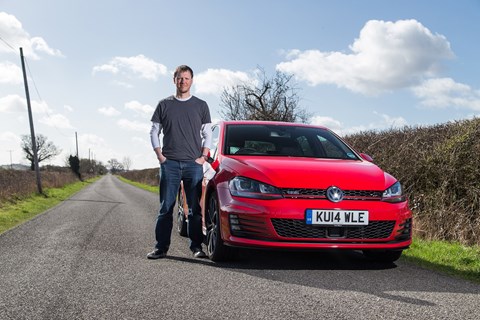► We spend a year in a Golf GTI Mk7
► Is it still the best hot hatch all-rounder?
► Read our long-term test review
Month 11 running a VW Golf GTI Mk7: the end of the year-long test
Road testers are supposed to have sophisticated taste. I’m often asked which is my favourite car and I like to reply ‘oh, the Saoutchik Hispano-Suiza H6C Dubonnet Xenia Streamliner’. Not because it’s true, but because there isn’t a more impressive sounding car name on the planet. In fact, the Xenia looks like a 1930s Zeppelin with a droopy sad-face, but I can’t tell the truth – I can’t say ‘actually, I’d like to drive a Golf every day’. That’s like being an interior decorator and painting your entire house magnolia. Or being a wine connoisseur and choosing the house red.
Actually, I do want to drive a Golf every day – this Golf. Because over the last 12 months our long-term GTI has proved itself a great family car, a commuter car, a long-distance car, and yes, a sports car too. The most damning thing I can think to say about it is that the Golf R is a bit better.
It’s a Goldilocks car. Supercars can be a hassle – they’re amazing when you focus on them, but driving them to work, in a rush and distracted… trust me, you start to yearn for a bit of normality. At the other end of the scale, the average family cold porridge is no good if – like me – you want to turn the radio off every once in a while and drive home like a twit.
The Golf GTI just fits every category. It’s the epitome of the practical five-door hatch – boxy and spacious. Over the last 12 months it’s frequently been rammed to the ceiling with baggage for family holidays or trips to the rubbish tip. As a commuter car it’s well equipped, it’s comfortable on long journeys, and it’s full of connective tech. On cold mornings I get in, turn on the (optional) heated seat and the radio, my phone automatically connects to the Bluetooth and I tap my destination postcode into the (optional) 8in touchscreen sat-nav. And it’s not just that this car is new – I recently borrowed the latest Renault Scenic, and hated the software and ergonomics. No, the Golf just feels brilliantly designed, engineered and executed in the German style, and over the last year I haven’t found a single niggle or fault with the interior.
The only glitch I did encounter was with the electric handbrake – it kept applying itself, unexpectedly, in reverse. Turns out it was because I have this absent-minded habit of popping my seatbelt off to look over my shoulder – the car notices, and thinks it’s dangerous. But more than anything, I’ve enjoyed my GTI as a sports car. The 227bhp 2.0-litre turbo (my car’s fitted with the optional Performance Pack) is sharp like a diamond-tipped blade, punching with torque from low revs and singing to the redline as sweetly as a race car. It’s proper fast – the official 0-62mph time of 6.4 seconds can’t convey the satisfaction of a second- or third-gear burst between corners, or the swiftness of an overtaking move. And unlike other hot hatches, this front-drive chassis feels comfortable with the power. As well as the extra 10bhp, that £995 Performance Pack also brings a fancy limited-slip diff, which gives the Golf a wonderful precise feeling in all but the slidiest conditions. I love the steering (speed sensitive, but you never notice) and the leather-bound wheel too.
Another option we have is Adaptive Chassis Control, which allows you to choose between Sport, Comfort and Normal suspension settings. It costs £815, but to be honest, I haven’t used it much – Comfort’s a bit soft, I occasionally tried Sport when I was giving it beans; there’s an Economy mode too, which I tried for about an hour; but mostly it was left in Normal. If you’re mulling over the online configurator, and you have £1000 to spend, choose the Performance Pack.
Altogether then, this is a five-star car. After 40 years, a verdict that says ‘the Golf GTI is good’ is hardly news, but this car has colossal appeal, and even when the GTI reaches 100, I think this Mk7 will still stand as a high point in its history. If you already own one, I’m jealous.
By Mark Walton
Month 10 running a Volkswagen Golf GTI Mk7: we fit winter tyres. And wish we hadn't
They said it was going to be a weather bomb, an Arctic blast, a deadly polar vortex that would have us all spinning into a new Ice Age. Better get some winter tyres then.
Thing is, since then – in the south at least – we had some lovely sunshine and a couple of gusts of wind. As they say, never let the weather get in the way of a good story.
Still, the Golf has spent winter on top-spec Pirelli Sottozero 3s, the latest ‘high performance’ winter tyres, and on snow Pirelli reckons they’ll cut stopping distance from 30mph from 52 metres to just 12. Impressive claim. Problem is, the chunky tread isn’t great for the handling when it’s warm and dry – blame the sipes, apparently.
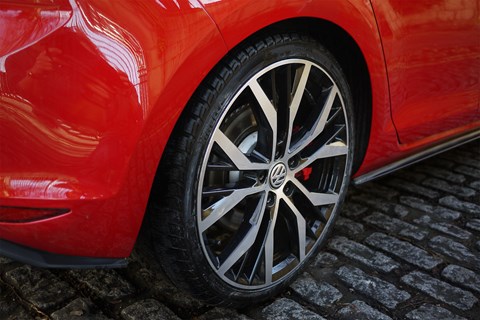
Interesting word that: sipes. John Sipe worked in an abattoir in 1923, the story goes, and he was tired of slipping on the wet floors, so he cut some extra thin grooves into his rubber soles. They made such a difference he patented the idea, and now these extra cuts in tyre blocks are called Sipes. I did not know that.
Anyway, they’re playing havoc with my GTI’s normally super-sharp handling – the confidence-inspiring ‘bite’ on turn-in has gone, and the grip feels mushy mid-corner. Seriously, if we don’t get a terrifying Day After Tomorrow-style weather catastrophe soon, with icebergs, I’m going to be annoyed.
By Mark Walton
Month 9 running a Volkswagen Golf GTI Mk7: the oil light's come on...
So we’re 12,000 miles into our long-term test of the Golf GTI, and suddenly the incidental running costs have flickered into life. Did I say incidental? I meant accidental – the first thing I needed to sort out was the damaged bumper, with the jagged split in the plastic caused by a parking accident. I wasn’t sure how big a job it might be – one of those scenarios where you imagine the guy saying ‘Sorry guv, the whole rear suspension’s got to come off. And we’ll probably have to take all the seats out, too’.
I called my local, small-town VW dealership, Robinsons, who told me they no longer handle body repair on site, as their workshop isn’t big enough, so they use a small independent round the corner. So I popped round to see Tony Cousins of Stamford, in his back-street lock-up. Not quite the premium main dealer experience I was expecting, but it was homely, and Tony came straight out to see the car. ‘You’re lucky,’ he said. ‘A lot of plastic bumpers these days, like your BMWs, they won’t melt; but the plastic in these Volkswagens, they’re fine’. So he gave me two options – melt the bumper to get it back into shape, fill, rub down and paint, £150; or he would of course buy a brand new GTI bumper from VW parts, estimated at £250, then paint and fit. I like this informal approach to car repair. The car is booked in.
The second cost was much more minor, but probably even more of a surprise than finding the damaged bumper: the oil light came on. I can’t remember the last time I drove a car that needed oil in the first nine months. Anyway, I checked the dipstick and sure enough it was low, so I stuck in a litre of expensive synthetic stuff. The GTI is on a long-life service regime, so doesn’t see a dealer until 30,000 miles/2 years. A quick Google search came up with quite a few owners on forums talking about oil use. If you’ve got a GTI that drinks too much of the stuff, let us know.
By Mark Walton
Month 8 running a Volkswagen Golf GTI Mk7: how economical is it?
A weekend in North Yorkshire to see my family (see picture) meant a Friday night blast up the A1. It’s a pretty frustrating journey – the ‘Great North Road’ is gradually being widened to three lanes, but the old two-lane sections through Notts and South Yorks are always packed bumper-to-bumper, and you drone along at 55mph. I should count my blessings – there are single-lane sections north of Newcastle.
I was playing with the Golf’s driving modes on the way up – there’s a menu on the touchscreen offering Comfort, Normal or Sport. I usually stick to Normal, but there’s also an Eco mode. I thought I’d try it. This reconfigures the engine, climate control and (bizarrely) the ‘Dynamic Bend Lighting’ (swivelling bi-xenons) to save fuel.
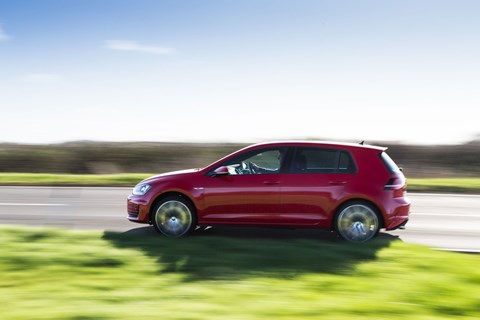
The only thing you notice is a slightly duller throttle pedal – it feels like you’re driving through treacle. I also monitored the instant consumption reading on the dashboard, to see if Eco made any difference. It did – toggling between Normal and Eco at 60mph, watching the dash while trying not to crash, Eco registered an instant 1mpg gain. This made me feel strangely elated.
Eco has since contributed to a slightly improved 28.9mpg, up from 28. A long way to the claimed 47mpg, but I’m not sure I can bear much more treacle.
By Mark Walton
Month 7 running a VW Golf GTI Mk7: this or a Golf R?
Normally you’d expect the price to be the headline: at £30,555, the new Golf R is almost double the cost of a boggo-basic entry-level Golf (a snip at £16,975). But if, like me, you’re lucky enough to be driving a GTI that’s been optioned up to the eyeballs, and would set you back an astonishing £32,500, suddenly the new R isn’t so intimidating; in fact, it starts to look like good value.
Unlike the more extreme R32s of the past, the latest 4x4 UberGolf isn’t some wild child that’s escaped from the VW skunkworks – it’s just a grown-up extension of the GTI. Power is up from 227bhp to 296bhp, thanks to a bigger turbo and a modified cylinder head; the 0-62mph time is down, from the GTI’s 6.4sec to 5.1. But in its character, the way it goes about its business, the R is so similar to the GTI, I’m glad the press car arrived in blue, to help distinguish it.
In detail, I prefer the R’s front bumper, with the GTI’s ‘Testarossa’ strakes removed; and I like the quad pipes at the rear. Otherwise, you’d need to be an expert to spot the discreet badging, or the 20mm lower suspension. The biggest visual difference is probably the wheels, and I actually prefer my GTI’s optional ‘Santiago’ alloys over the R’s ‘Cadiz’ rims.
Inside’s the same story – there are minor tweaks, like the R’s semi-alcantara seats, and the gloss black dashboard finish; but these are just option differences rather than anything fundamental – really, these are twins separated at birth, with the same architecture, the same steering wheels, and (in these examples) the same ‘Discovery Pro’ sat-nav options with 8in screens.
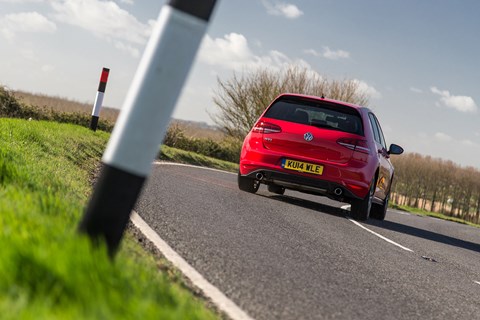
The biggest difference is just the handling, the way the all-wheel-drive R feels completely at ease with close to 300bhp. The GTI’s fancy front diff is amazing at dialling out the understeer and torque interference, but on the limit there’s no disguising all that energy feeding into your steering; whereas, if you chuck the R into a couple of corners – really load it up, so the 4Motion Haldex system starts feeding power to the back axle – and you can really feel the R is more comfortable at speed.
It feels like it’s lapping it up, rather than fighting you. I absolutely love our red GTI, it’s fast, and until now I’ve been happy with the handling. But the R has turned me: it’s undoubtedly a better car, and depending on how you spec it, it could be cheaper too. I’d probably lose my licence, but I want one.
By Mark Walton
Month 6 running a VW Golf GTI: someone's bashed the bumper
Sadly our Golf GTI has been damaged up the back bumper. More cynical readers will accuse me of reversing into something, despite the fact that our car is fitted with the standard parking sensors. (front and rear beepers, plus a graphic representation on the dashboard. A rear-view camera is an additional £165 option.) Come on, I’m possibly the world’s greatest parker, I wouldn’t do that.
No, I reckon someone has reversed into me – probably with a tow bar, by the looks of it, and most likely while the car was parked in our local multistorey, where the GTI spends most of its days. Unfortunately the damage is more than just a surface scratch – there are two nasty puncture wounds that have broken through the bumper, so it must have made a really ugly, plasticky crunch when they did it. I need to get over to my local Volkswagen dealership and get the repair costed up. I dread to think how much it’ll be, for someone else’s stupid, momentary lapse of concentration. Care to take a guess? What a ball-ache.
By Mark Walton
Month 5 running a VW Golf GTI: we want a manual handbrake!
From the outside looking in, non-enthusiasts must think all car magazines are deadly dull and boring, and probably full of stories about camshafts and axles. Well, I’m about to write 200 words about a handbrake, so if you don’t want to be implicated as a car-nerd cliché, look away now.
I love our Golf GTI in practically every way, but one thing that annoys me every time I drive is the electronic handbrake. It has an auto hill-hold, which is occasionally helpful, but most of the time I never know whether it’s going to engage or not, which kind of defeats the object. Worst of all, the handbrake itself (not the release-when-you-move hill-hold, I mean the actual grab-and-don’t-let-go handbrake) keeps coming on when I stop and put the car in reverse. I release the clutch, and instead of smoothly rolling backwards, the car jerks up at the rear as the chassis tries to drive over the stuck-fast rear wheels. When I look down, the handbrake is on. Why does it do this? Am I doing something wrong? And why don’t manufacturers offer a manual handbrake lever as an option? (Everyone would choose it.)
On the subject of auto braking, the Golf also has Front Assist, a forward-facing radar that detects obstacles; plus City Emergency Braking, which slams on the anchors for you if you fail to respond. The other day I was crossing an empty junction when the front brakes suddenly engaged so violently, I almost head-butted the windscreen. I think the radar detected a pothole, and thought I was driving over a cliff.
By Mark Walton
Month 4 running a VW Golf GTI: the fab multi-media screen
Readers who followed my reports on our long-term-test Ford Kuga last year will no doubt remember how much I hated its old-fashioned Sony music and navigation system, with a million tiny buttons and a screen the size of a Bourbon biscuit.
One of the very best things about stepping into our new Volkswagen Golf GTI this year has been the VW’s ‘infotainment’ system, which feels absolutely bang–up-to-date and is a cinch to use. It’s all focused around an 8in colour touchscreen (a bit bigger than an iPad mini), set in the centre of the dash and within easy reach; there are then four hard buttons each side, that allow you to quickly switch from navigation to radio to phone.
A really cool feature is a small, invisible sensor, set in the dashboard, that detects your hand when you move towards the screen; this animates the content – either bringing up an invisible menu, making the buttons larger, or highlighting key points in red – just before your pointed index finger reaches its destination.
It’s like using the Force, lacking only a ‘zzshweoahr’ electronic lightsabre noise to make it pure sci-fi gold. I admit, I often add the noise myself, under my breath, as I hover my hand, back, and forth; back, and forth: zzshweoar, zzshweoar, zzshweoar.
By Mark Walton
Month 3 running a VW Golf GTI: the tartan seats
When did German manufacturers start using tartan fabric for their seats? Even more importantly, why? I’ve tried to find out, but I don’t have a definitive answer; certainly it dates back to the 1950s, when Mercedes-Benz used different coloured tartan trim for each of its drivers: Stirling Moss’s race seat was always blue, Fangio’s was red, Karl Kling’s was green. Most people associate tartan with 1970s Porsche 911s, or the classic Mk1 Golf GTI of 1975. I guess by then it was a reference to those earlier German racing cars, twenty years earlier, but I have no idea why it started in the first place. If anyone knows, please write in.
The tartan connection with the Golf is so strong, Volkswagen decided to make the red ‘Jacara' tartan the standard trim in the new Mk7 (you can choose optional black leather for an extra £1700). I love the trim, though my kids – who probably think Karl Kling is a German fashion brand – have absolutely no idea why I ordered it. They think it’s a kind of joke – like ordering a Mickey Mouse clock for the dashboard.
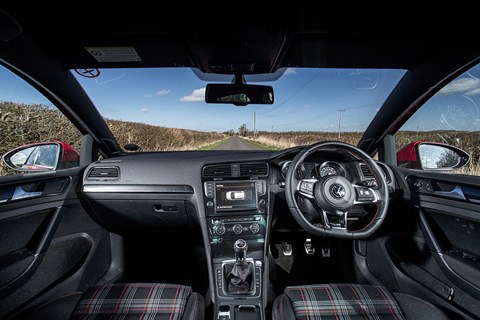
If the tartan is one of my favourite styling details on the Golf, the weird strakes on the front spoiler are my pet hates. Clumsy and boy-racerish, they look like something straight off a Ferrari Testarossa, circa 1984.
Funny thing is, on most roads the Golf would leave a 1980s Ferrari for dead. This is a seriously quick car: ours has the optional Perfromance Pack which means 227bhp peak power (10 more than the standard GTI); VW claims the 0-62mph time is 6.4 seconds, which admittedly isn’t as impressive as a 1980s Testarossa (0-60 in 5.2). But it’s the way the Golf puts that power down that makes it such a weapon – that Perfroamnce Pack also includes the trick electro-mechanical front diff, which mean you can get back on the Golf’s throttle ridiculously early in a corner – when the Testarossa driver is still tentatively avoiding an uncontrolled reverse into the hedgerow, the Golf is already gone, foot planted to the next corner.
The way it puts the 258 lb ft of torque through the front wheels is impressive enough in the dry, without any horrible torque steer, keeping any rampant understeer in check; but in the wet it’s just crazy. You can absolutely fling the car into a bend and get your foot down by mid-corner – yes, the yellow traction warning light will blink on the dashboard, but the car will just track through the bend true to your chosen course.
The traction control is clearly intervening, but it’s not as though the acceleration feels blunted either; it’s just fast in, fast out. Imagine exiting a corner like that in a Testarossa, on wet night on your way home from work? Forget it – the Golf is a giant killer, in that great hot-hatch tradition, and fully worthy of the tartan chairs.
By Mark Walton
Month 2 running a VW Golf GTI (Mk7): the Golf turns family wagon
Like many Golf GTI drivers, I want our new long-termer to be two cars in one: when I’m on my own I want it to be a hot hatch, all pointy and racy; but I also need it to be a practical family car that’s big enough for all our baby clobber. A blend between Ayrton Senna and Nanny McPhee, if you can picture that.
We’ve been out for a couple of family trips so far. Fitting the car seat was no problem – the Isofix bars were easily accessible behind clip-on plastic covers – and for bigger people, there’s plenty of leg- and headroom in the back.
Things are a little tighter in the boot: despite the new model being bigger (380 litres in the back vs the Mk6 Golf’s 350), the VW isn’t renowned for its luggage space.
Travelling with one toddler is fine, because the 70:30 split rear seat allows you to surround the baby with luggage (and she’s too young to complain); but travelling with a baby plus one or two more kids? We’d need to hire a van to follow us round. Which means I need three cars in one.
By Mark Walton
Month 1 running a VW Golf GTI (2014): introduction and spec details
Journalists love anniversaries. They provide a reason for a story, giving it backbone, making it look credible, making it look like the journalist really knew what he was doing when he embarked on it, and the whole thing wasn’t just some tenuous idea, flung together at the last minute.
Which is why I’m pleased to announce this year is the very significant 39th anniversary of the launch of the MkI Golf GTI, at the 1975 Frankfurt Motor Show. What better year to take on the new Mk7 VW Golf GTI, than this… the 39th?
Hey, I’m not complaining. Though I liked and admired our outgoing Ford Kuga long-term test car, I’m feeling rather smug about my new daily drive: jumping out of an SUV, the new Golf immediately feels low, compact, sharp and fast. I feel like I’m driving a racing car every day.
The spec of our new arrival is the unofficial ‘Enthusiast’s Choice’: it’s the got the £995 Performance Pack (which means bigger brakes, an electro-mechanical limited slip diff, and 10bhp over the standard GTI); it has the £815 Adaptive Chassis Control (giving it three suspension settings, Comfort, Normal and Sport); the sensational-looking Santiago 19-inch alloys (a £985 option); the sat-nav upgrade with an eight-inch touchscreen (£1765); a hi-fi upgrade (£530); and the keyless entry and starter button (£355).
Add all that to the standard-fit sports suspension (15mm lower than bog standard spec); the six-speed manual gearbox (rather than the optional DSG); and the ‘Jacara Red’ tartan seats (classic touch), and you’ve got the absolute state-of-the-art Golf GTI for the year 2014.
Add in a couple of other options (bi-xenon headlights, heated front seats and heated washers all come as part of the £355 winter pack) and the standard on-the-road price of £26,780 is swelled to £32,580. That makes it significantly more than the (more powerful) Focus ST we ran last year, but you don’t have to drive the Golf GTI far to realise its appeal is about much more than its 227bhp.
It’s not news that the Golf is beautifully put together, but still, all I can say is it hits you forcefully when you first get acquainted – everything your hand touches, from the fat-rimmed steering wheel to the heater controls to the door handles, everything feels microscopically engineered and perfectly detailed. Regular readers will know I got pretty fed-up with the Ford’s in-car entertainment and sat-nav system – stepping into the GTI felt like I’d fast-forwarded through time. It’s slick, modern, with a big screen, nice graphics, and great usability.
On the road the Golf certainly isn’t a rip-roaring drive like a hot Renault Megane or (if you like torque steer) the Focus ST: the Golf, by comparison, is permanently and unshakeably ‘composed’ – steady, dependable, fast certainly, but not lairy. I’m still exploring the limits of that clever electro-mechanical front diff, but I have a feeling there is no ‘inner demon’ waiting to be unleashed: it just grips and goes, with very little drama and lots of speed. Will I find it a little too composed over time? Will I yearn for a more playful chassis? More worryingly, will the Golf prove big enough for my baby-buggy-and-car-seat family needs? I’ll be making the most of this special anniversary year to find out.
By Mark Walton
